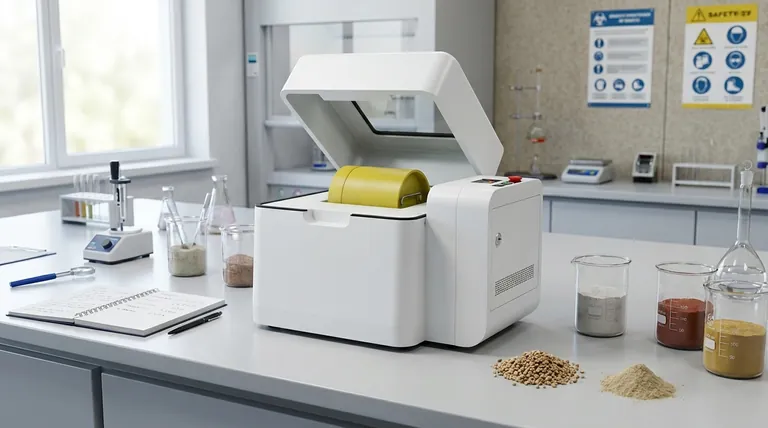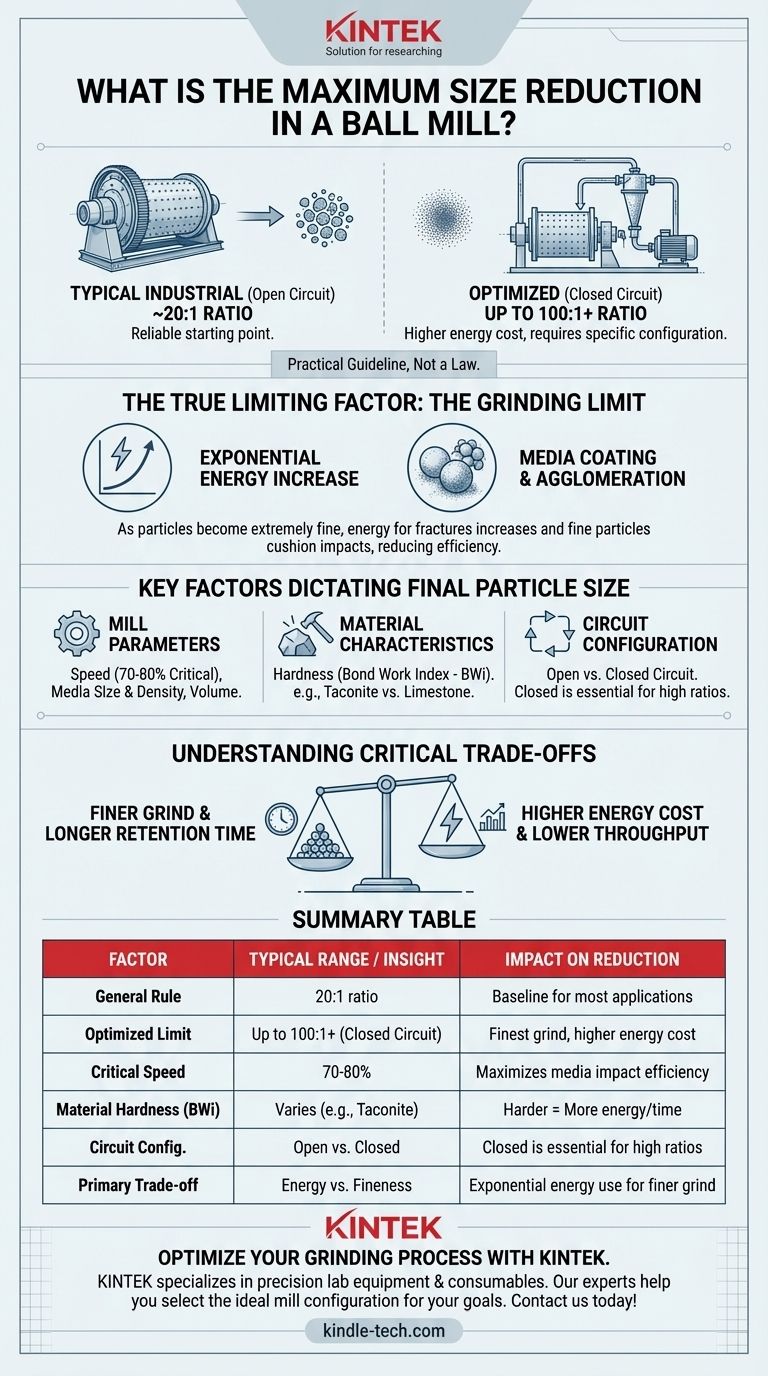For a typical industrial ball mill, the maximum size reduction ratio is generally considered to be around 20:1. However, this is a practical guideline, not a physical law. Under optimized conditions and with specific circuit configurations, reduction ratios can reach as high as 100:1 or even more, but this comes with significant trade-offs in energy consumption and throughput.
The concept of a single "maximum" size reduction is misleading. The true limit is a dynamic balance between the material's properties, the mill's configuration, and the economic point of diminishing returns, where the energy required for further grinding becomes prohibitive.

Deconstructing the "Reduction Ratio"
The reduction ratio is a simple comparison of the feed particle size to the product particle size. While useful for initial estimates, understanding what governs this ratio is far more important for any practical application.
The Common Rule of Thumb
For most general-purpose grinding circuits, a 20:1 ratio is a reliable starting point for design and expectation. This means if you feed 20 mm material into the mill, you can reasonably expect to achieve a product where 80% of the particles are smaller than 1 mm.
Pushing the Operational Limits
Achieving a 100:1 reduction ratio is possible but requires a highly optimized system. This typically involves using a closed-circuit grinding setup, where the mill's output is sent to a classifier (like a hydrocyclone) that separates fine particles from coarse ones.
The fine particles exit the system as the final product, while the oversized coarse particles are sent back to the mill for further grinding. This prevents the mill from wasting energy over-grinding particles that are already small enough.
The True Limiting Factor: The Grinding Limit
As particles become extremely fine (typically entering the micron range), two phenomena create a practical limit.
First, the energy required to create new fractures increases exponentially. Second, the fine particles can begin to coat the grinding media (the balls), cushioning the impacts and drastically reducing grinding efficiency. At this point, the material may even start to agglomerate, effectively stopping any further size reduction.
Key Factors That Dictate Final Particle Size
The final particle size you can achieve is not a single number but the result of several interconnected variables. Controlling these is the key to efficient grinding.
Mill Operating Parameters
The speed of the mill is critical. It's typically operated at 70-80% of its "critical speed"—the theoretical speed at which the grinding media would centrifuge and cling to the mill shell. This range maximizes the cascading and cataracting actions that are responsible for grinding.
The size, density, and volume of the grinding media also play a central role. Larger, denser balls are used for breaking coarse feed, while smaller balls provide the greater surface area needed for finer grinding.
Material Characteristics
The inherent properties of the material being ground are paramount. The Bond Work Index (BWi) is a standard measure of a material's hardness and resistance to grinding.
A hard material like taconite will require significantly more energy and retention time to achieve the same size reduction as a softer material like limestone.
Circuit Configuration
As mentioned, a closed-circuit system is far more efficient and capable of producing a finer product than an open-circuit one. By continuously removing properly sized particles, the closed circuit allows the mill to focus its energy exclusively on the material that still needs to be ground.
Understanding the Critical Trade-offs
Optimizing a grinding circuit is always an exercise in balancing competing priorities. Understanding these trade-offs is essential for making sound operational decisions.
Energy vs. Fineness
This is the most fundamental trade-off. Grinding is an energy-intensive process, and the energy cost rises exponentially as the target particle size decreases. Doubling the fineness of the product can often more than double the energy consumption.
Throughput vs. Retention Time
To achieve a finer grind, the material must spend more time inside the mill (longer retention time). This directly reduces the overall processing rate, or throughput, of the system. You must decide whether a finer product is worth a lower production rate.
Making the Right Choice for Your Goal
Your optimal setup depends entirely on your primary objective. There is no single "best" way to operate a ball mill; there is only the best way for your specific goal.
- If your primary focus is maximizing throughput for a coarse product: Operate in an open circuit or with a coarse classifier setting, use larger grinding media, and maintain a high feed rate.
- If your primary focus is achieving a very fine, specialized product: You must use a closed-circuit system with an efficient classifier, smaller grinding media, and be prepared for higher energy costs and lower production rates.
- If your primary focus is optimizing energy efficiency: Focus on closed-circuit operation, maintain the correct media charge level, and precisely control the mill speed and slurry density to avoid wasting power.
Ultimately, the limitations of a ball mill are defined less by physics and more by economics and process requirements.
Summary Table:
| Factor | Typical Range / Key Insight | Impact on Size Reduction |
|---|---|---|
| General Rule of Thumb | 20:1 reduction ratio | Baseline for most industrial applications |
| Optimized Limit (Closed Circuit) | Up to 100:1 or more | Achieves finest grind but with higher energy cost |
| Critical Operating Speed | 70-80% of critical speed | Maximizes grinding media impact efficiency |
| Material Hardness (Bond Work Index) | Varies by material (e.g., Taconite vs. Limestone) | Harder materials require more energy and time |
| Circuit Configuration | Open vs. Closed Circuit | Closed circuit is essential for high reduction ratios |
| Primary Trade-off | Energy Consumption vs. Particle Fineness | Finer grinding exponentially increases energy use |
Optimize Your Grinding Process with KINTEK
Are you looking to maximize throughput, achieve a super-fine product, or improve energy efficiency in your lab or production line? The right ball mill configuration is key to hitting your targets.
KINTEK specializes in precision lab equipment and consumables, offering solutions tailored to your specific grinding needs. Our experts can help you select the ideal mill, media, and circuit configuration to balance fineness, throughput, and cost-effectiveness.
Contact us today to discuss your application and let KINTEK provide the reliable equipment and expert support you need for superior size reduction results.
Get in touch with our grinding experts now!
Visual Guide

Related Products
- Laboratory Single Horizontal Jar Mill
- High Energy Planetary Ball Mill Machine for Laboratory Horizontal Tank Type
- Laboratory Planetary Ball Mill Rotating Ball Milling Machine
- Laboratory Horizontal Planetary Ball Mill Milling Machine
- High-Energy Omnidirectional Planetary Ball Mill Milling Machine for Laboratory
People Also Ask
- What size is a ball mill? A Guide from Benchtop to Industrial Scale
- What is the procedure of a ball mill experiment? Master Particle Size Reduction for Your Lab
- What is the particle size range of a ball mill? Achieve Precise Grinding from 10 mm to Sub-Micron
- What is the product size of a ball mill? Achieve Micron-Level Precision for Your Materials
- What are the application of ball mill in food industry? Achieve Ultra-Fine Grinding for Superior Food Quality



















